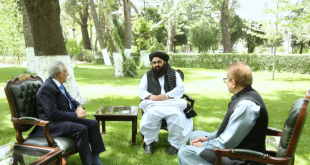By NAJIBULLAH LOODIN
Under the neo-realist theory, water conflicts have been broadly covered by media around the world (Julien, 2012). Titles such as “It’ll cause a water war: division run deep as filling of Nile Dam nears”; Blood on the Nile is what’s coming if Egypt and Ethiopia continue their war of words over water; “River of the Dammed, Ethiopia’s continued efforts to dam the Nile could end in war with Egypt. Here’s how to stop that from happening”; Will Central Asia fight over water? (The Guardian, 2020; Independent, 2020; Foreign Policy, 2019; BBC, 2016 respectively) highlight the risk of conflict over shared water resources and characterize disagreement between riparian states. For example, during his official visit to Astana on September 7, 2012, Islam Karimov, the former president of Uzbekistan has warned upstream-ers, Kyrgyzstan and Tajikistan, that their efforts of constructing dams in the upstream will spark war (Eurasia net, 2012), or the former president of Egypt, Mohammad Morsi, expressed that the construction of ‘Grand Ethiopian Renaissance dam’ (GERD) would lead to war confrontation between Egypt and Ethiopia.
The riparians of a shared river basin have different interests in the use of water resources. Whilst one state might be interested in hydro-power generation and expansion of irrigation scheme- e.g., Afghanistan as the upstream state in Harirud River Basin- the downstream state, Iran fears of the negative effects of dam construction on the river’s flow of Harirud River which will affect its agricultural development potential. Moreover, while one state might use the shared river as an output tank for industrial pollution, another state might perceive it as a threat for its drinking water supply system. As a result of different interest of co-riparians, disagreement and conflict often emerge between the states, especially when the downstream state perceives that the unilateral resource capturing strategy of the upstream-er, e.g., construction of dams, will threat its water security (see also, Julien, 2012; Schmeier & Vogel, 2018).
Despite the threatening examples of water conflict, cooperation outweighs between riparians in a shared river basin. According to Wolf et al. (2003), conflict, in its various form, has been significantly rare in internationally shared rivers (currently there are more than 270 international river basins and lakes) (see also De Stefano et al., 2010; Schmeier & Vogel, 2018). Instead, riparian states have been committed to engaging in cooperative mechanisms and arrangements in order to prevent conflict and dispute over the shared water resources (Schmeier, 2017). They have realized that cooperative mechanisms would benefit the riparians and have committed to long-term cooperation and collaboration through international water treaties (IWT) and adopting institutional mechanism for implementing their commitments- most often in the form of River basin Organizations (RBOs). Cooperation in an internationally shared river basin not only ensures the interest of the engaging parties, but also ensures the sustainable water governance of the basin as a whole (Schmeier & Vogel, 2018).
International efforts for managing shared river basin through establishment of ‘international water law’ have intensified since late 20th century. These efforts were developed at various national and regional levels and codified in international and regional conventions and agreements over time. The most significant principles of international water law are the principles of ‘equitable and reasonable use of the shared water resources’; ‘commitment for cooperation’; and the obligation not to trigger ‘significant harm’. While ensuring the sustainability of the shared river basin, the riparians are obliged to cooperate with each other in utilizing the shared water resources (Schmeier, Gerlak, & Blumstein, 2015; Schmeier & Vogel, 2018). The abovementioned international water law principles and norms have been codified and legally bounded through the 1997 UN Convention on the Law of the Non-Navigational Uses of International watercourses (UN Watercourse Convention) (see also, UN, 1997) and the 1992 Helsinki Convention/ UNECE Water Convention (see UN, 1992) (cited in Schmeier & Vogel, 2018).
Hence, these principles ensure the practical basis for sustainable management of the shared water resources. However, the principles of international water law encounter enforcement challenges. Riparians do not comply with these norms and principles. The key question is, thus, whether all co-riparians of a shared river basin realize the benefits of joint water resources management or not and whether the joint water resources management ensures the interests of each riparian or not. Therefore, river basin management is the means to ensure the interest of each co-riparian taking their hydrological, political, socio-economic and environmental specificities into consideration (Schmeier & Shubber, 2018; Schmeier & Vogel, 2018; Schmeier at al., 2015).
References
Ahmed Aboudouh @AAboudouh. “Egypt and Ethiopia Are Heading for War over the Water in the Nile | Ahmed Aboudouh.” The Independent, Independent Digital News and Media, 10 Mar. 2020, www.independent.co.uk/voices/egypt-nile-war-water-ethiopia-clash-dam-trump-a9390271.html.
De Stefano L, Edwards P, DeSilva L, Wolf A (2010) Tracking cooperation and conflict in international river basins: historic and recent trends. Water Policy 12(6):871–884
Harb, Imad K. “River of the Dammed.” Foreign Policy, 15 Nov. 2019, foreignpolicy.com/2019/11/15/river-of-the-dammed/.
https://treaties. un.org/Pages/ViewDetails.aspx?src¼TREATY&mtdsg_no¼XXVII-12&chapter¼27&lang¼en.
Julien, Frédéric. “Hydropolitics Is What Societies Make of It (or Why We Need a Constructivist Approach to the Geopolitics of Water).” International Journal of Sustainable Society, vol. 4, no. 1/2, 2012, p. 45., doi:10.1504/ijssoc.2012.044665.
Lillis , Joanna. “Uzbekistan Leader Warns of Water Wars in Central Asia.” Eurasianet, eurasianet.org/uzbekistan-leader-warns-of-water-wars-in-central-asia.
Michaelson, Ruth. “’It’ll Cause a Water War’: Divisions Run Deep as Filling of Nile Dam Nears.” The Guardian, Guardian News and Media, 23 Apr. 2020, www.theguardian.com/global-development/2020/apr/23/itll-cause-a-water-war-divisions-run-deep-as-filling-of-nile-dam-nears.
Qobil, Rustam. “Will Central Asia Fight over Water?” BBC News, BBC, 25 Oct. 2016, www.bbc.com/news/magazine-37755985.
Rieu-Clarke, Alistair, et al., editors. “Routledge Handbook of Water Law and Policy.” 2017, doi:10.4324/9781315651132.
Schmeier, Susanne, and Birgit Vogel. “Ensuring Long-Term Cooperation Over Transboundary Water Resources Through Joint River Basin Management.” Riverine Ecosystem Management, 2018, pp. 347–370., doi:10.1007/978-3-319-73250-3_18.
Schmeier, Susanne, and Zaki Shubber. “Anchoring Water Diplomacy – The Legal Nature of International River Basin Organizations.” Journal of Hydrology, vol. 567, 2018, pp. 114–120., doi:10.1016/j.jhydrol.2018.09.054.
Schmeier, Susanne, et al. “Clearing the Muddy Waters of Shared Watercourses Governance: Conceptualizing International River Basin Organizations.” International Environmental Agreements: Politics, Law and Economics, vol. 16, no. 4, 2015, pp. 597–619., doi:10.1007/s10784-015-9287-4.
United Nations (1992) United Nations treaty collection, convention on the protection and use of transboundary watercourses and international lakes, Helsinki, 17 Mar 1992. https://treaties.un.org/Pages/ViewDetails.aspx?src¼TREATY&mtdsg_no¼XXVII-5&chapter¼27&lang¼en.
United Nations (1997) United Nations treaty collection, convention on the law of the non-navigational uses of international watercourses, New York, 21 May 1997.
Wolf A, Yoffe S, Giordano M (2003) International waters: identifying basins at risk. Water Policy 5:29–60
The writer is M.Sc. in Water Governance and Management at Oregon State University- USA, IHE (Institute for Water Education), the Netherlands and University for PEACE, Costa Rica
 Afghanistan Times
Afghanistan Times




